For the last decade, Red Bull Salzburg have been the most dominant team in Austrian football, with the Wals-Siezenheim-based side winning the last nine Austrian Bundesliga titles.
While most seasons it has not been a close title race, this season has been different, as Christian Ilzer’s Sturm Graz have given Salzburg a run for their money in the title playoff.
Since Ilzer joined the Austrian club in the summer of 2020, he has established them as the second-best team in Austria and brought them success on the European stage as well.
This success has led to the 45-year-old being linked with jobs outside of Austria, such as the then-vacant job at Schalke last fall.
Ilzer has enjoyed tremendous success at SK Sturm Graz so far, and the Austrian title is still in reach this season at the time of writing.
This tactical analysis and scout report will examine Christian Ilzer’s tactics at SK Sturm Graz in more detail and determine why he has been linked with bigger clubs across Europe.
Christian Ilzer Style Of Play & Preferred Formation
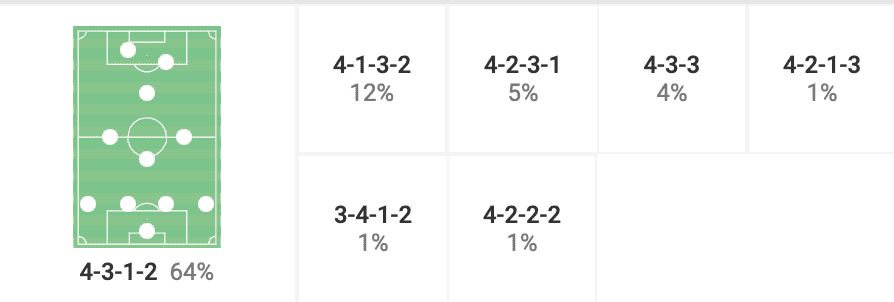
As the image above shows, Ilzer always sets his Sturm Graz side up in a 4-4-2 diamond, and this shape does not vary much from match to match.
However, the shape does often look different during the attacking phases of play and the pressing phase.
Due to the narrowness of this shape, Ilzer relies on his full-backs to progress into the attacking third and offer the width, with them becoming almost like wingers when Sturm Graz are in possession.
A lot of Ilzer’s side’s creative attacking moments originate from the wide channels, with the full-backs being the main antagonists during phases where Sturm is looking to build up more cautiously.
Another point to make is that Ilzer’s sides do not look to control possession, with his Sturm Graz side averaging just over 48% of the ball this season.
Instead, they look to counter-press when possession is lost in advanced areas, hoping to force the opposition into an errant pass or turnover that allows the Austrian side to transition quickly and effectively.
Having a diamond in midfield and pushing them high also allows Sturm Graz to often create an overload in midfield, which plays a huge part in not allowing opposition sides to play through their pressing shape.
Ilzer’s side has the second-best press, statistically, in Austria.
Under Christian Ilzer’s coaching style, Sturm has also conceded the second-fewest goals in Austria this season, with 18, second to Salzburg’s 16.
Ilzer expects his side to have a compact mid-block when forced into defensive moments.
They normally like to defend high up the pitch, winning possession back shortly after losing it.
Sturm has faced the fewest shots of any side in Austrian football this season.
Christian Ilzer Build up style
When watching Christian Ilzer’s Sturm Graz side this season, they do not generally prefer a slow and methodical build-up.
Christian Ilzer style of play instead prefers a much quicker vertical style of build-up play.
However, they still play the ball short of the goalkeeper, with the diamond shape slightly altered for these moments.
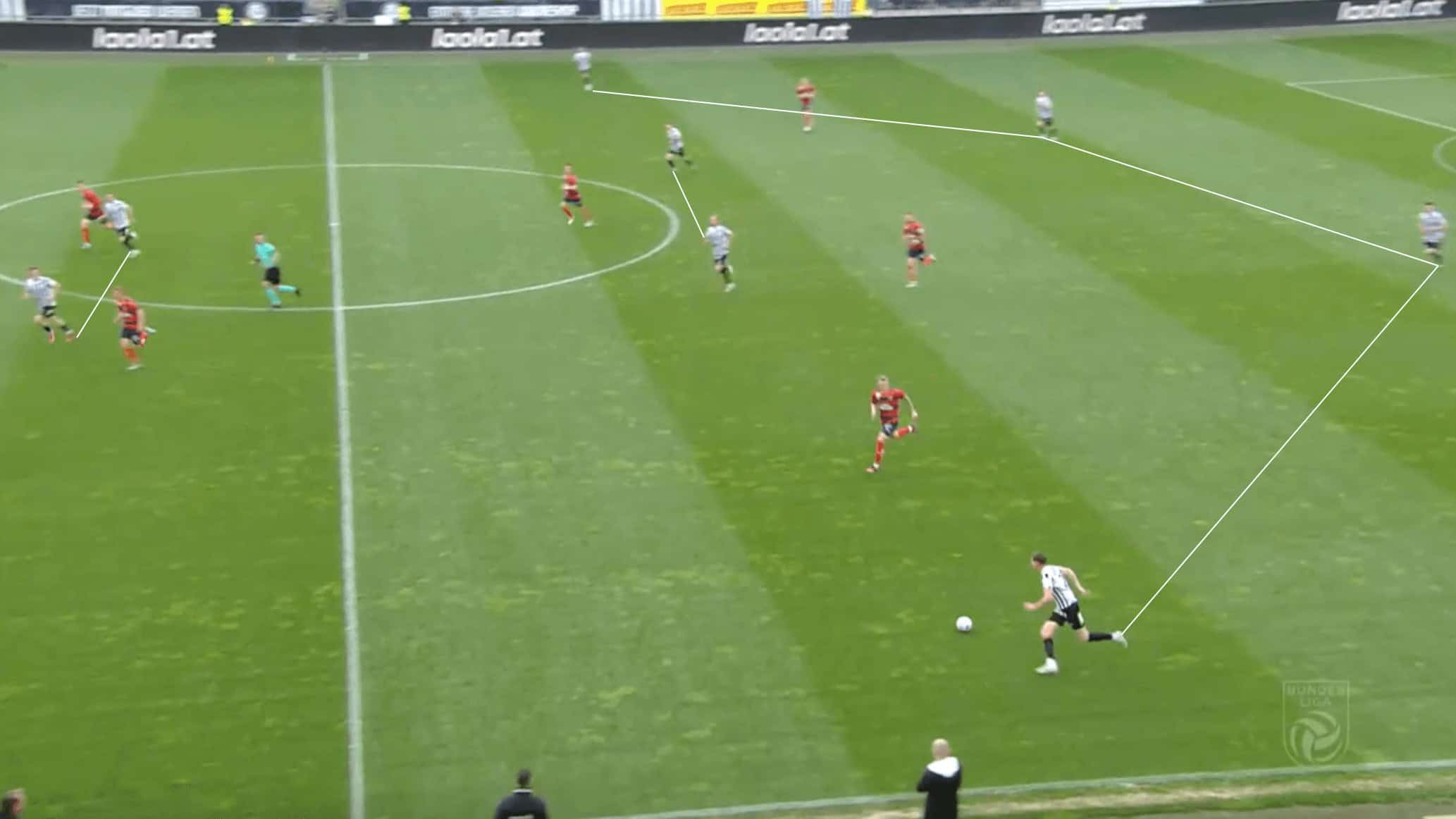
The image above shows this change in Sturm Graz’s shape when they build out from the back.
The diamond shape turns into a 4-2-2-2, with the two deeper midfielders dropping to sit in front of the back four.
This deep positioning of the midfielders keeps the opposition’s shape narrow, allowing the space out wide for the full-backs to drive into.
This forms the basis for how Christian Ilzer wants his sides to attack: with quickness and verticality.
The full-backs are heavily utilised, essentially playing more as wingers in the attacking half.
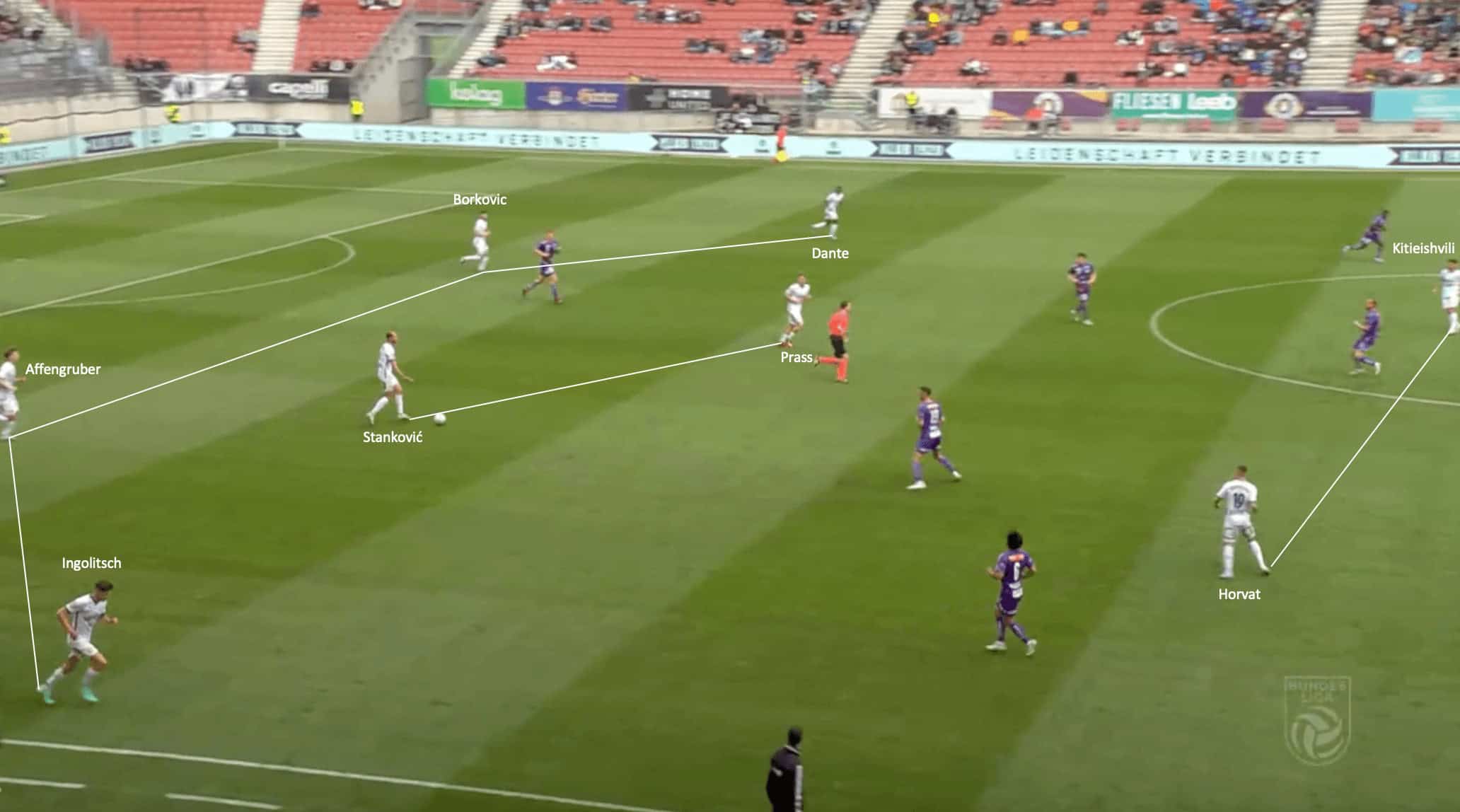
The image above shows another example of the 4-2-2-2 shape that Christian Ilzer’s Sturm Graz typically transitions to during the build-up phases of play.
The back four can be clearly made out, with Sandro Ingolitsch and Amadou Dante the two full-backs who are beginning to get more advanced but are looking to hold the width.
Centrally, Stanković, who is in possession, is usually the base of the diamond, with former RB Salzburg youth product Alexander Prass, one of the outside midfield players, dropping next to him.
Further advanced are Tomi Horvat, along with the #10 Otar Kiteishvili.
As already mentioned, this more narrow shape during build-up allows SK Sturm Graz to pull the opposition into central positions to prevent overloads in midfield.
This allows space out wide for the full-backs to advance and enable Ilzer’s side to progress the ball through them.
Transitional Attacking Style Utilising Quick Ball Progression
With Ilzer looking to get his full-backs advanced to generate width, they become a crucial component of how he wants his Sturm Graz side to attack.
Ilzer wants his side to generate attacking chances often, so seven or eight outfield players normally advance into the attacking areas when Sturm Graz is in possession.
The width of the fullbacks allows the outside players in the diamond to stay in the lines, looking to find space in the pockets to receive centrally.
However, as already mentioned, under Christian Ilzer, Sturm Graz does not appear to be a side that looks to hold the majority of possession.
Instead, they prefer transitional moments.
A lot of these attacks come from Ilzer’s very good counter-pressing system.
The Austrian manager looks for his side to progress the ball quickly in these transitional moments, looking to utilise quick one-touch passing sequences to take advantage of the opposition’s defence being out of position.
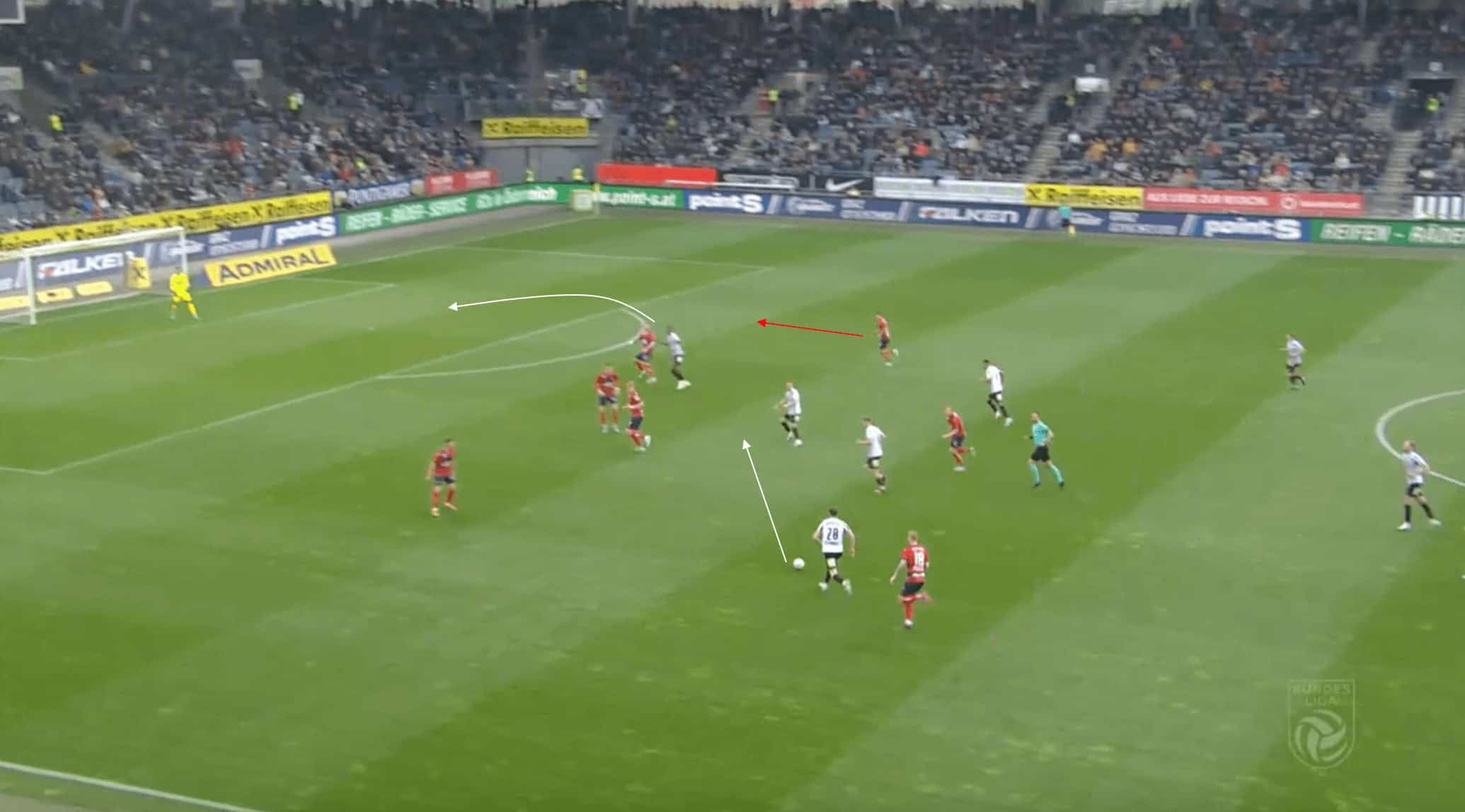
The image above shows an example of this quick attacking transitional move, which led to a goal for Christian Ilzer’s side.
Preceding this image, Sturm were able to force the opposition into a turnover using their aggressive counter-pressing style.
This led to the current phase in the image above, with the quick vertical ball progression allowing them to catch the Rapid Wien defenders out, with the full-back caught in an advanced position on the far touchline.
In only three passes, the ball reaches the forward making a run behind the out-of-shape opposition defence.
The forward can slot the ball home to score for Sturm Graz.
In this situation, Ilzer’s strategy of quickly regaining possession and hitting the opposition on transitional attacking moments is successful.
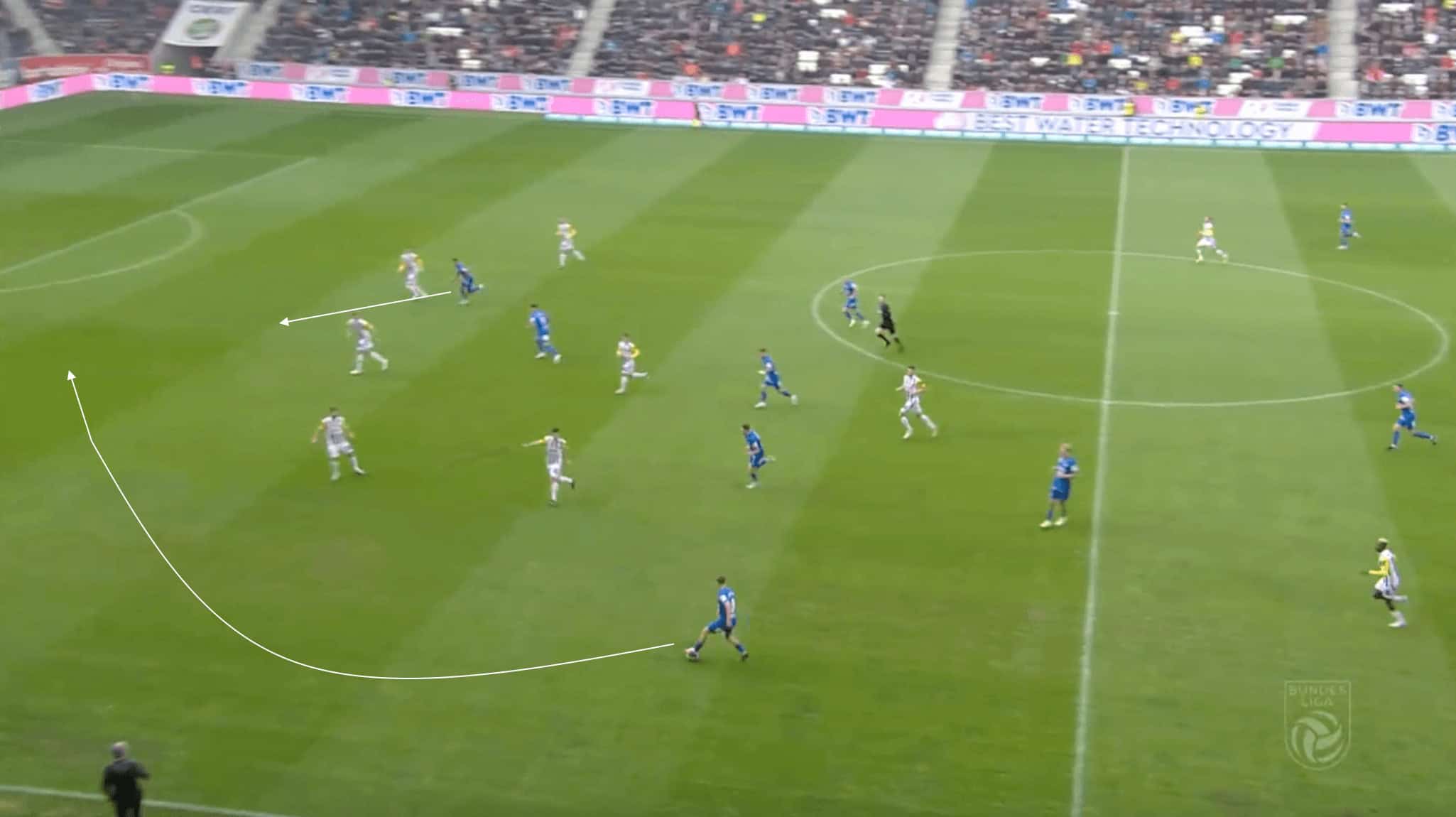
The image above shows another example of Sturm Graz using quick transitional attacking play to get into dangerous positions.
In this phase of play above, Ilzer’s side had just forced LASK into a turnover in midfield due to their aggressive pressing.
Once possession is turned over, the ball is played out wide to the full-back who is already in an advanced position.
Instead of attempting to play the ball into midfield, where Sturm Graz have an overload due to their diamond shape, he instead attempts to play the ball vertically into the space behind the LASK defenders for the striker to run onto.
Unfortunately, the ball is played slightly too late and the striker is called offside.
However, this example can illustrate exactly what Christian Ilzer wants from his side from an attacking perspective.
While his side does not hold much possession over the course of 90 minutes, their ability to strike quickly in transitional moments has made them such a dangerous side in Austria and Europe this season.
An aggressive counter-pressing system
What makes Christian Ilzer’s side stand out is the aggressive counter-pressing system that the Austrian manager has implemented.
They are statistically the second-best pressing side in Austria, with their 7.7 PPDA second only to RB Salzburg.
Sturm Graz High Regains Map
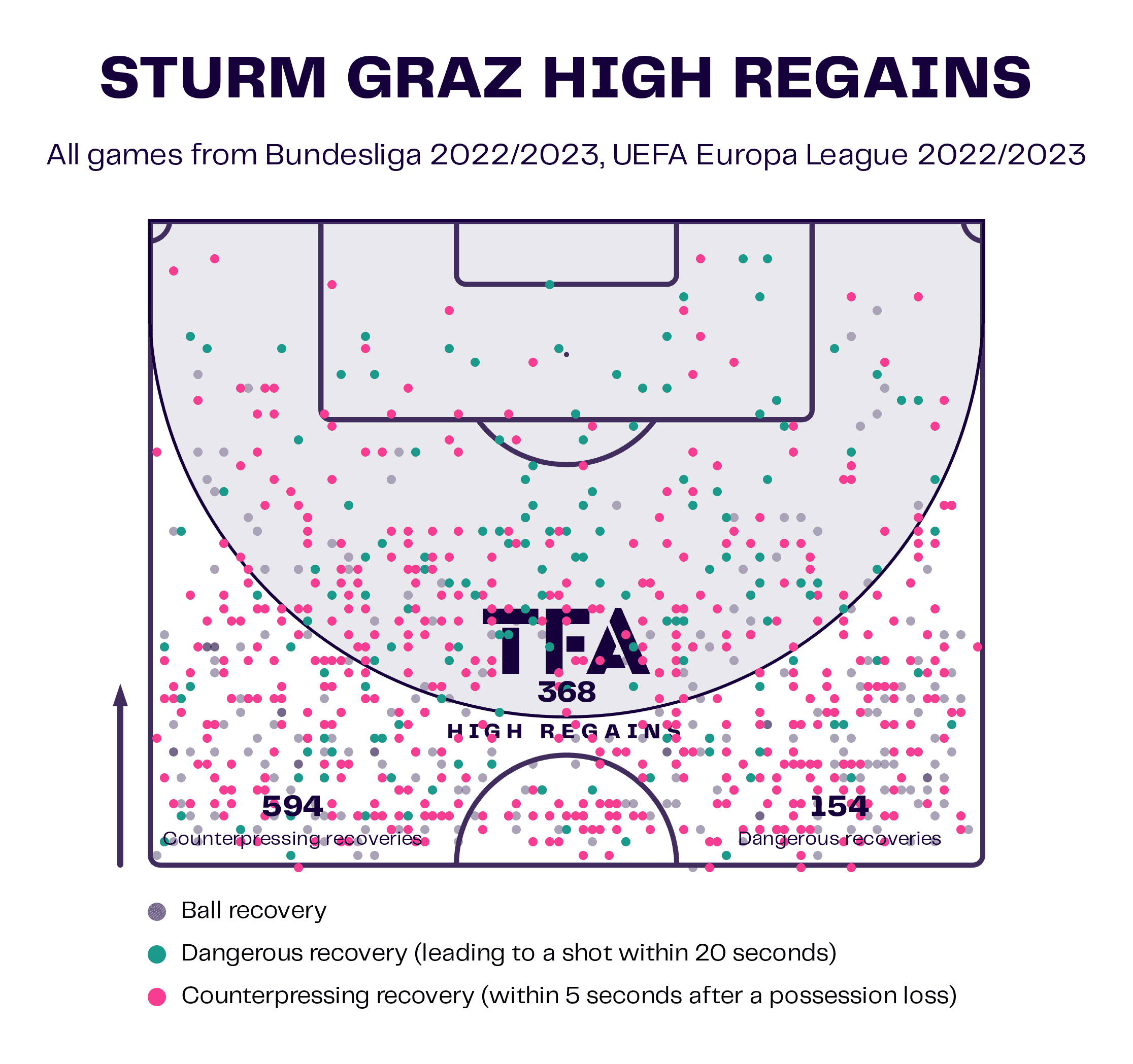
As the data visualization graphic above shows, Sturm Graz is very active in defensive actions and has high regains in the attacking half of the pitch.
In fact, Ilzer’s side have more high regains and more counter-pressing recoveries than Matthias Jaissle’s RB Salzburg side.
Along with them not conceding many goals this season, Sturm Graz’s ability to keep pace with Salzburg at the top of the Austrian Bundesliga this season has mainly been down to this aggressive counter-pressing.
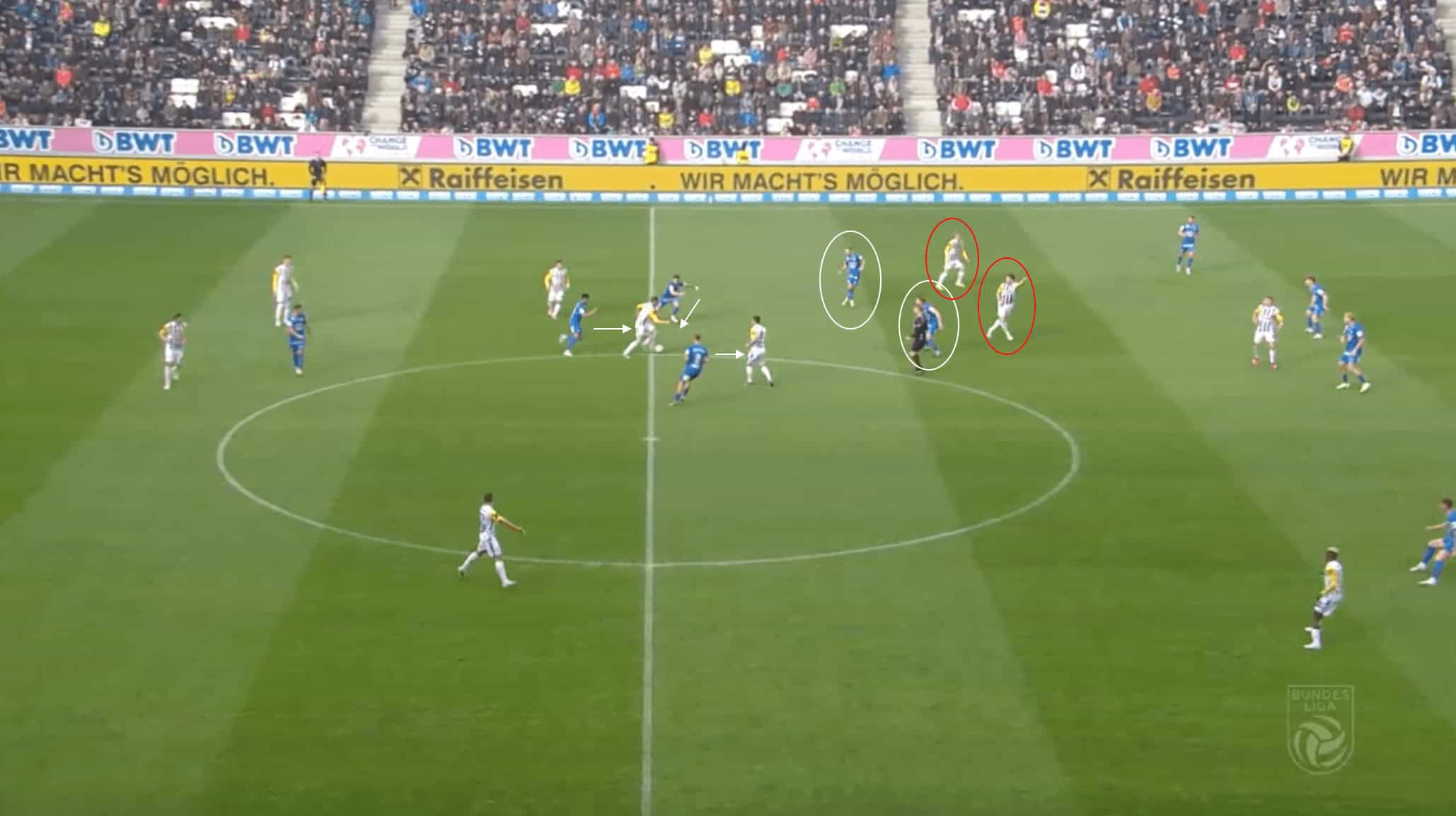
The image above shows an example of the quality that Christian Ilzer’s Sturm Graz possesses in counter-pressing moments.
In the phase of play above, Sturm had just turned possession over, with the ball being gathered by LASK near the midfield line.
As the opposition midfielder drives toward the Sturm Graz defensive third, two players quickly look to close him down.
Other potential passing options are blocked by other Sturm Graz players in the vicinity, forcing the LASK player to hold onto possession and continue to dribble forward.
Once he dribbles another few yards, all of the Sturm Graz players positioned closest to him close down and swarm the midfielder, winning back possession as a result.
The midfielders positioned deeper in midfield do well to eliminate the passing lanes to the advanced players, allowing them to engage the player in possession once he progresses the ball into a more advanced position.
This turnover results in another potential transitional attacking moment for Christian Ilzer’s side, all originating from the work rate that the Austrian has implemented since arriving at Sturm Graz.
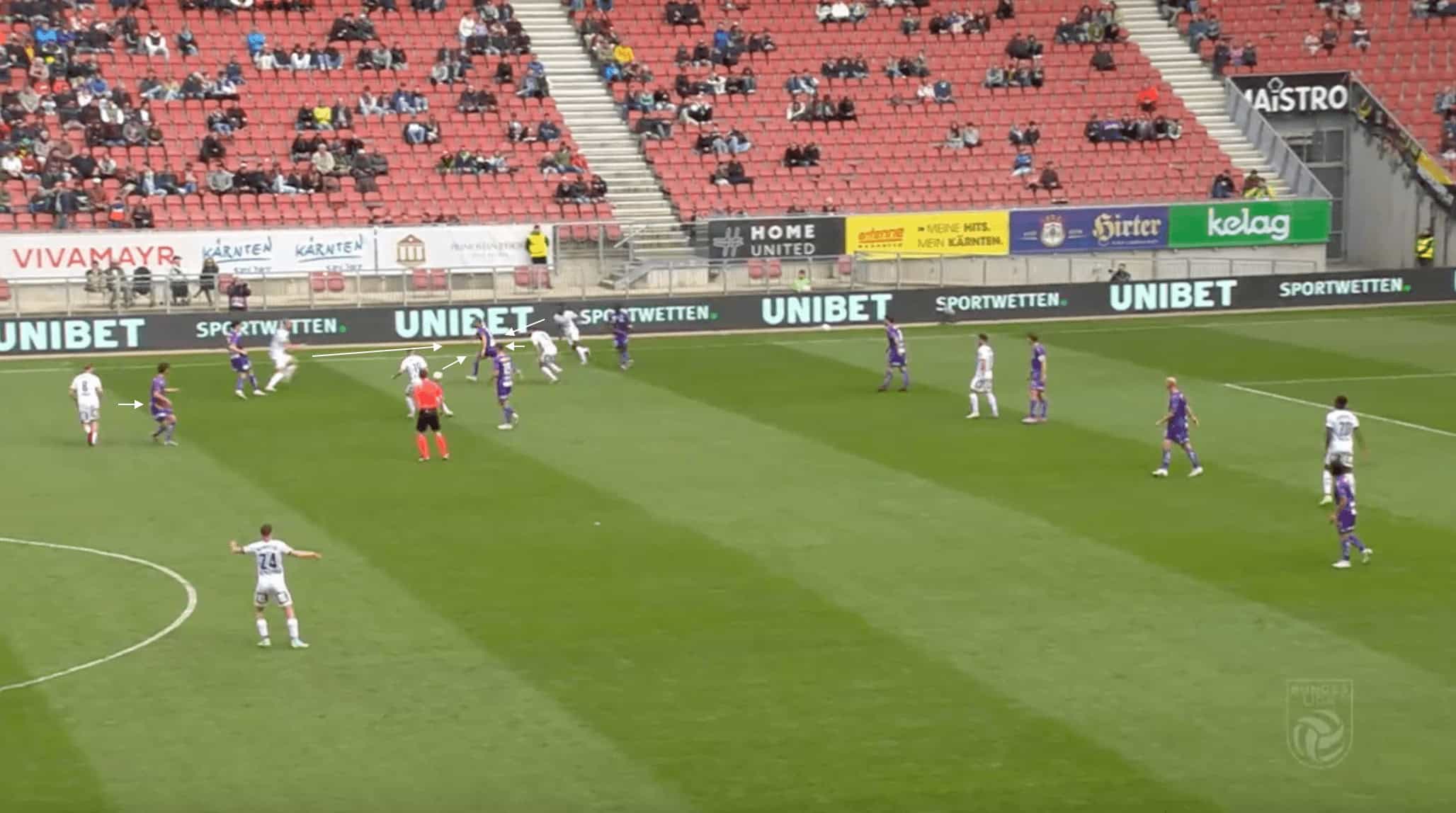
This image above provides another example of the emphasis and effort that Christian Ilzer places on his side to counter-press.
In this phase of play above against Austria Klagenfurt, Sturm had just turned over possession in the attacking half of the pitch.
Once an opposition player takes possession, four Sturm Graz players instantly swarm the ball carrier, looking to regain possession within a few seconds.
To help prevent the ball from escaping the side, it is currently locked into, the Klagenfurt players around the play are also tightly marked or passing lanes cut off, stopping the ball from being played to them to escape the press.
As this section has shown, Christian Ilzer’s tactics revolve around the pressing ability that his players demonstrate.
His aggressive counter-pressing helps lead to attacking chances going forward, and due to their success in this phase, they do not allow many goals defensively.
It would not be surprising to see Christian Ilzer depart Sturm Graz at the end of the current season, but his style of play means he would likely only be a good fit at certain clubs around Europe.
Where could Christian Ilzer end up?
When thinking about potential options for Christian Ilzer if he left Sturm Graz, the two leagues that come to mind for him to move to are the Bundesliga and the Premier League.
Clubs at the bottom or middle half of the Bundesliga would likely be good destinations for Ilzer, with Eintracht Frankfurt, a potentially interesting club to watch out for.
With their current Austrian manager, Oliver Glasner, currently linked to vacant jobs at Tottenham and Chelsea, that could be a realistic option for Ilzer.
When looking at England, Leeds United are the first team that stands out.
If they can stay up and avoid relegation to the Championship, this could be an interesting option if the club decides not to renew Javi Gracia’s contract.
Ilzer’s style is somewhat similar to former manager Jesse Marsch, but perhaps he could get the tune out of the players that the American manager could not.
All in all, it is more likely that Ilzer will make the jump to German football, at least first, with the links already in place there from last fall with Schalke.
Conclusion
As this tactical analysis and scout report has shown, Christian Ilzer is a manager to watch in the future.
He has done a great job in Austria, especially at Sturm Graz, where this season his side have been pushing RB Salzburg all the way through the title playoffs.





Comments